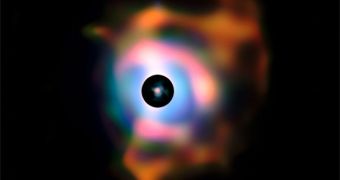Astronomers with the European Southern Observatory (ESO) recently trained one of their most important telescopes on an iconic target in space, the nebula that formed around the supergiant star Betelgeuse. The structure has now been observed in greater detail than ever before.
In order to capture the best available view, the team decided to use the Very Large Telescope (VLT), which ESO operates at the Paranal Observatory, in the Atacama Desert, Chile. The VLT VISIR instrument was selected as the best possible candidate to carry out the mission.
Eventually, the selection turned out to be the correct one indeed, seeing how the nebula seems to reveal its complexity and brightness in this new image. According to experts, this gas halo is formed by material being shed from the supergiant star.
When massive stellar objects reach the end of their burning cycles, they begin to shed the outer layers of their atmospheres, forming nebulae. After sufficient mass is lost, the star's core eventually collapses into a neutron star or a black hole, during a violent supernova explosion.
Some believe that Betelgeuse is on its way towards going supernova too. However, it is very difficult to predict precisely when the event will take place. This is why astronomers are constantly keeping an eye on the nebula and its central star.
The reason why studying Betelgeuse is so important is that the star is one of the largest and brightest known. It has a diameter nearly four and half times the diameter of the Earth’s orbit, or roughly the size of Jupiter's orbit around our Sun.
Its nebula extends to about 400 astronomical units. An AU is the mean distance between the Earth and the Sun, or around 93 million miles. The Betelgeuse nebula is some 60 billion kilometers across, and is located in the constellation Orion.
Due to its massive size, the star can afford to lose one solar mass every 10,000 years and still be alive. But the group of objects it belongs to is known for its inability to endure past several million years of life. Massive stars die young and violently.
“In this composite image, the earlier NACO observations of the plumes are reproduced in the central disc. The small red circle in the middle has a diameter about four and half times that of the Earth’s orbit and represents the location of Betelgeuse’s visible surface,” an ESO press release says.
“The black disc corresponds to a very bright part of the image that was masked to allow the fainter nebula to be seen. The VISIR images were taken through infrared filters sensitive to radiation of different wavelengths, with blue corresponding to shorter wavelengths and red to longer,” it concludes.

 14 DAY TRIAL //
14 DAY TRIAL //